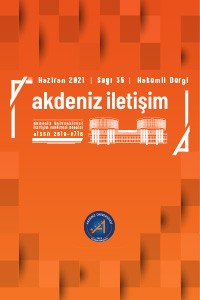Abstract
Tüm dünyayla birlikte Türkiyeyi de etkisi altına alan Corona virüs salgınından korunmak ve yayılmasını önlemek için T.C. Sağlık Bakanlığı’nın başlattığı “hayat eve sığar”, “evde kal” sloganlarıyla yurttaşların evde kalması çağrısı yapılmaktadır. Zaman zaman tatillerde ve hafta sonlarında da sokağa çıkma yasakları getirilmektedir. Bu süreç içerisinde canlı etkinliklerin hemen hemen hepsi ertelenmiş, insanların bir araya gelmelerini sağlayan birçok mekân ve alan kapatılmıştır. Söz konusu bu uygulamalar kişilerin evde kaldığı süre içinde oyalanmalarını sağlayacak alternatif arayışlarını arttırmıştır. Bu durum, Netflix’i önemli bir aktör olarak karşımıza çıkartmaktadır. Ancak Netflix vakit geçirmek için kullanılan bir araç olmanın ötesinde kullandığı yayın teknolojisi, sunduğu à la carte televizyon izleme deneyimi, toplumsal ve kültürel açıdan neden olduğu değişiklikler vb. yüzünden televizyon tarihi içerisinde yeni bir dönem başlattığı konusunda literatürde birçok tartışmaya konu olmaktadır. Bu çalışmada da öncelikle Netflix’in televizyon tarihinde yeni bir dönem açıp açmadığı kavramsal olarak tartışılmıştır. İncelenen kavramsal yapı içindeki unsurlar dikkate alınarak, Netflix kullanıcılarının Twitter paylaşımları üzerinden Netflix’i nasıl değerlendirdikleri ve bu değerlendirmenin tartışılan kavramsal yapıya katkı sağlayıp sağlamayacağı incelenmiştir. Yapılan veri analizi sonucunda literatürde Netflix’in yeni bir dönem başlattığı iddia edilen teknolojisi, izleme deneyimi, kataloglaması, geliştirdiği algoritmalar vb. hakkında herhangi bir paylaşımda bulunulmadığı gözlemlenmiştir. Yapılan paylaşımlar içerisinde ekseriyetle canlı yayında yapılacak programlara ilişkin duyuruların bu çalışma kapsamında belirlenen etiketlerle paylaşıldığı tespit edilmiştir.
References
- Ateşalp, S. T. & Başlar, G. (2020). İnternette dizi izleme pratiklerinin dönüşümü: Aşırı izleme (binge- watching) üzerine bir araştırma. Galatasaray Üniversitesi İletişim Dergisi, (32), 108-136 . https://doi.org/10.16878/gsuilet.560832
- Bolter, J.D. & Grusin, R.A. (1999). Remediation: Understanding New Media. Cambridge, MA: MIT Press.
- Burroughs, B. (2019). House of Netflix: Streaming media and digital lore. Popular Communication, 17(1), 1-17. https://doi.org/ 10.1080/15405702.2017.1343948.
- Burroughs, B., & Rugg, A. (2014). Extending the broadcast: streaming culture and the problems of digital geographies. Journal of Broadcasting & Electronic Media, 58(3), 365–380. https://doi.org/10.1080/ 08838151.2014.935854.
- Caldwell, J. T. (2008). Production Culture: Industrial Reflexivity And Critical Practice in Film And Television. Durham, NC: Duke University Press.
- Curtin, M. (2009). Matrix media. J. Tay & G. Turner (Der.). Television Studies after TV: Understanding Television in the Post-Broadcast Era içinde (s. 9 – 19). London: Routledge.
- Dias, M.O. (2020). Netflix: from Apollo 13 to the Coronavirus Pandemic. Global Scientifi Journals. 8 (8), 21 – 35. https://doi.org/10.11216/gsj.2020.08.42678.
- Dixon, W. W. (2013). Streaming: Movies, Media, And İnstant Access. Lexington and Kentucky: The University Press of Kentucky.
- Elo, S., & Kyngas, H. (2007). The qualitative content analysis process. JAN Research Methodology, 107-115. https://doi.org/10.1111/j.1365-2648.2007.04569.x.
- Gómez, E. F. & Quevedo, J. M. (2018). Connecting with audiences in new markets: Netflix´s Twitter strategy in Spain. Journal of Media Business Studies, 15 (2), 127-146. https://doi.org/10.1080/16522354.2018.1481711. Feuer, J. (2007). HBO and the concept of quality TV. J. McCabe, ve K. Akass (Der.). Quality TV: Contemporary American Television and Beyond (s. 139 -153). New York, NY: Palgrave Macmillan.
- Gezgin, S. (2018). Televizyon 4.0. TRT Akademi, 3(6), 580 – 589.
- Graneheim U.H., & Lundman B. (2004) Qualitative content analysis in nursing research: concepts, procedures and measures to achieve trustworthiness. Nurse Education Today, 24, 105-112. https://doi.org/10.1016/j.nedt.2003.10.001.
- Halvey, M. & Keane, M. T. (2007). An Assessment of Tag Presentation Techniques Archived 2017-05-14 at the Wayback Machine, poster sunumu.
- Hills M (2007) From the box in the corner to the box set on the shelf. New Review of Film and Television Studies, 5(1), 41–60. https://doi.org/10.1080/17400300601140167.
- Helic, D., Trattner, C., Strohmaier, M., Andrews, K. (2011). Are tag clouds useful for navigation? A network-theoretic analysis. International Journal of Social Computing and Cyber-Physical Systems, 1(1), 33 – 55. https://doi.org/10.1504/IJSCCPS.2011.043603. ISSN 2040-0721.
- Jenner, M. (2014). Is this TVIV? On Netflix, TVIII and binge-watching. New Media & Society, 8(2), 257– 273. https://doi.org/10.1177/1461444814541523.
- Jenner, M. (2018). Netflix and the Re-invention of Television, Cambridge, UK: Palgrave Macmillan.
- Johnson, D. (2018). From Networks to Netflix: A Guide to Changing Channels. London: Routledge.
- Keating, G. (2017). Netflixed: The Epic Battle for America's Eyeballs. New York: Penguin Books.
- Kompare, D. (2005). Rerun Nation: How Repeats Invented American Television. New York, NY: Routledge.
- Kompare, D. (2006). Publishing flow: DVD box sets and the reconception of television. Television & New Media, 7(4), 335–360. https://doi.org/10.1177/1527476404270609.
- Lobato, R. (2019). Netflix Nations The Geography of Digital Distribution. New York: New York University Press.
- Lotz, A. D. (2014). The Television Will be Revolutionized, 2nd ed. New York: New York University Press.
- Medina, M., Urgellés, A., & Herrero, M. (2016). Netflix´s arrival into the Spanish market: Friend or foe. European media management association, EMMA Konferans 2-4 Haziran 2016, University of Porto, Portekiz.
- Murschetz, P. (2016). Connected television: Media convergence, industry structure, and corporate strategies. Annals of the International Communication Association, 40(1), 69–93. https://doi.org/10.1080/23808985.2015.11735256.
- Newman, M. Z. (2014). Video Revolutions on the History of a Medium. New York: Columbia University Press.
- Pearson, R. (2011). Cult Television as Digital Television’s Cutting Edge. J. Bennett ve N. Strange (Der.). Television as Digital Media (s. 1248–1592) içinde. Durham, NC: Duke University Press.
- Plothe, T. & Buck, A.M. (2019). Netflix at the Nexus Content, Practice, and Production in the Age of Streaming Television. New York: Peter Lang Publishing.
- Steel, E. (2020, October 16). Cord-cutters rejoice. New York Times. 02.06.2020 Tarihinde erişilmiştir https://www.nytimes. com/2014/10/17/business/cbs-to-offer-web-subscription-service.html
- Walsh, J. (2020). Netflix Subscriber Growth Slows After Surging During Pandemic. 25.05.2020 Tarihinde erişilmiştir.https://www.forbes.com/sites/joewalsh/2020/10/20/netflix-subscriber-growth-slows-after-surging-during-pandemic/?sh=17ab492b244e
- Williams, R. (1974). Television. Technology and Cultural Form. Glasgow: Fontana.
- Yıldırım, A., & Şimşek, H. (2013) Sosyal Bilimlerde Nitel Araştırma Yöntemleri. Ankara, Turkey: Seçkin Yayıncılık.
Details
| Primary Language | Turkish |
|---|---|
| Subjects | Communication and Media Studies |
| Journal Section | Articles |
| Authors | |
| Publication Date | June 30, 2021 |
| Submission Date | February 27, 2021 |
| Published in Issue | Year 2021 Issue: 35 |
Journal of Akdeniz University Faculty of Communication is licensed under a Creative Commons Attribution-NonCommercial 4.0 International License (CC-BY-NC).

